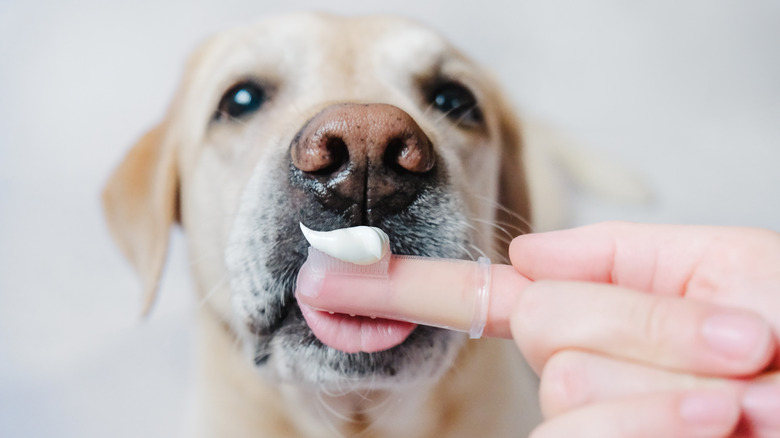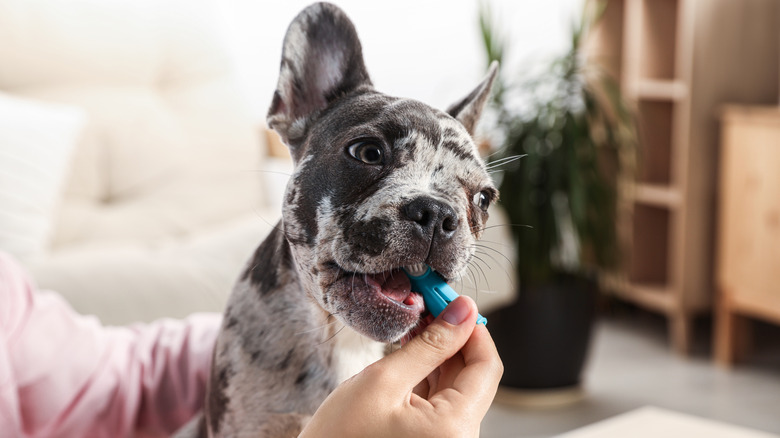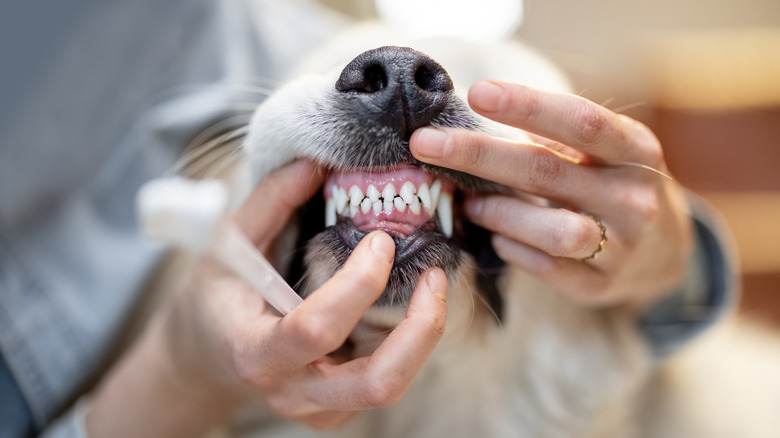Avoid These 3 Ingredients When Taking Care Of Your Dog's Teeth
We may receive a commission on purchases made from links.
Dental problems are a common veterinary issue in dogs. A 2021 study in the Journal of Small Animal Practice showed that out of 22,333 dogs tested, 12.5% suffered from dental disease. The rates were higher among smaller breeds like toy poodles and Cavalier King Charles spaniels due to tooth crowding and jaw shape. Up to 85% of dogs over the age of three suffer from some degree of periodontal disease. Proper dental care is a key component of a dog's continued health, and brushing is the most effective way for a pet parent to manage plaque buildup in their pet.
While human toothpaste may seem innocuous, it often contains three ingredients to avoid when brushing a dog's teeth: fluoride, sodium lauryl sulfate (SLS), and xylitol. Fluoride is sometimes added to drinking water and has been found in dog food, but it is toxic to dogs and can be fatal in higher quantities. Sulfates, used as cleansing and foaming agents, appear in many household products, including dog shampoos, but can cause skin irritation and infections in dogs. Xylitol, a common sugar substitute, is highly toxic to dogs. Even small amounts can trigger hypoglycemia (low blood sugar), seizures, or liver failure. Choosing the right toothpaste and avoiding these ingredients will help ensure healthy teeth and safe products for your dog.
Picking the proper toothpaste
The best way to ensure you get safe, vet-approved teeth-cleaning products is to look for those endorsed by reputable organizations. The Veterinary Oral Health Council (VOHC), established in 1997 to provide clear information to consumers on dental health products, has a list of approved retail items.
For toothpaste, the only VOHC-recommended brand is Petsmile Professional Pet Toothpaste. Another pet-friendly dog toothpaste is Virbac's CET Enzymatic Toothpaste. If you're looking for a more natural, and safe, pet toothpaste, Radius' USDA Organic Dental Solutions Kit offers some.
Talking about your dog's oral hygiene is one of the most important questions to ask a veterinarian. They may recommend other specific products in addition to toothpaste catered to your pet's needs. These can include formulated dental diets, chews, water additives, and other items that can help between dental cleanings. A vet or vet tech can also help show a pet parent how to brush a dog's teeth properly.
Brushing your dog's teeth at home
Even after picking out approved products for your dog and getting advice from the vet, cleaning a dog's teeth at home can be daunting. Preparing a dog for teeth cleaning can be key to helping them be receptive to the process. In addition to dog-safe toothpaste, you'll want to have a dog-friendly toothbrush or finger brush on hand to make the process easier.
The American Kennel Club shows you how you can get your pup used to having their gums and teeth touched by you, as well as a tutorial on proper brushing techniques. You can slowly introduce toothpaste on your finger once they're comfortable. Picking a good time, especially for a nervous pup, can also help ensure the process goes smoothly. Afterward, offer some teeth-friendly treats for a job well done. Avoiding human toothpaste with harmful ingredients and introducing a dog-friendly option can help keep your pup's teeth sparkling in between their regular veterinary visits.


